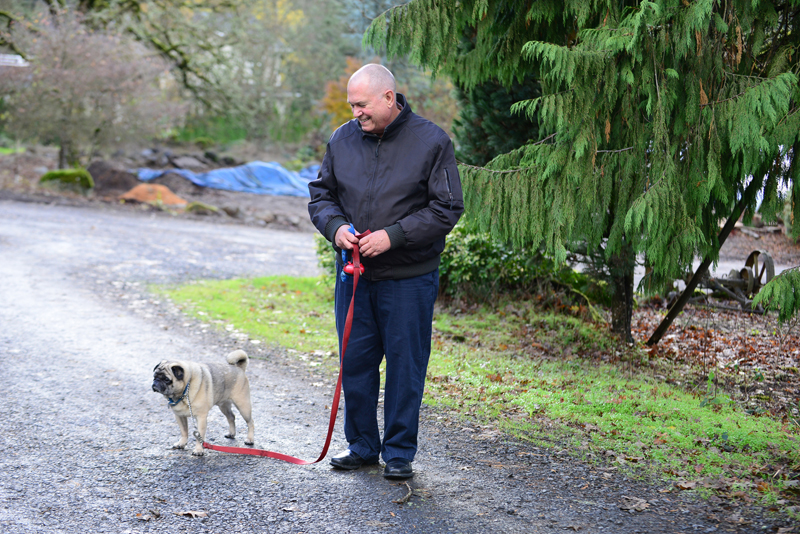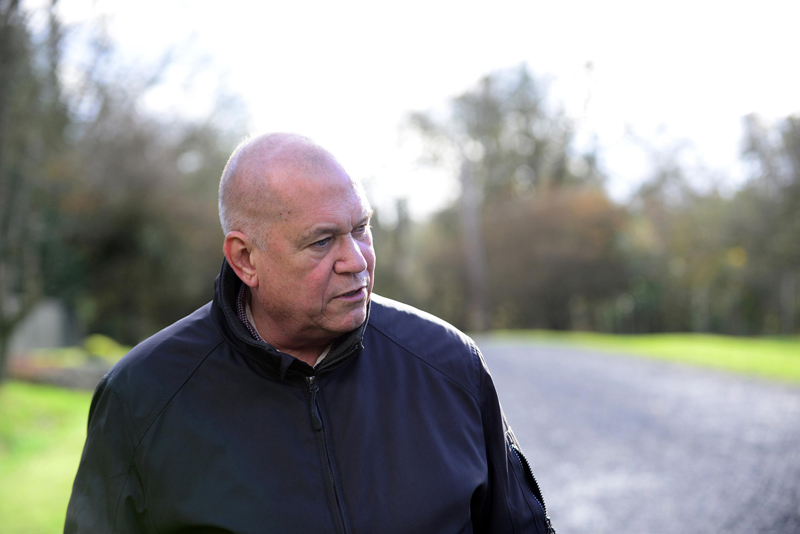
Dr. Peter Rasmussen, a retired medical oncologist who led the Death With Dignity movement and defended the Oregon law in the U.S. Supreme Court, takes his dog, Pugsley, for a walk around their East Salem neighborhood on Dec. 3, 2014. Photo by Danielle Peterson/Statesman Journal, courtesy of USA Today
SALEM, Ore. — Dr. Peter Rasmussen, a national advocate for legalizing physician aid in dying, died Tuesday (Nov. 3) with the help of Oregon’s Death with Dignity law, his family said.
Rasmussen, 70, was an oncologist who was passionate about caring for terminal patients and ensuring that they could make own their medical choices in the face of death. He was diagnosed with grade 4 glioblastoma, a malignant brain tumor, in spring 2014.
Rasmussen’s wife, Cindy Rasmussen, said her husband was surrounded by family when he took a lethal dose of drugs to end his life.
She described his last moments as peaceful. He died 30 minutes after taking the medicine.
The family had a private ceremony Sunday before his death to honor him and share memories.
READ: We have a right to pigheaded ideas. Now what should we do? (COMMENTARY)
Rasmussen was one of the few physicians who dared to speak in support of Oregon’s Death with Dignity ballot measure in the 1990s, and his medical career at times took a hit from his controversial stance. Even after Oregon voters approved the measure, state and national forces sought to shut down the policy.
He ultimately joined a group of plaintiffs suing the federal government, which had attempted to nullify Oregon’s law.
In 2001, then-U.S. Attorney John Ashcroft said he would penalize doctors who prescribed federally controlled substances to help patients die. The U.S. Supreme Court heard the case and decided in support of Oregon in January 2006.
Former state Rep. George Eighmey, a Democrat from Portland, Ore., who worked with Rasmussen to keep the law from being blocked, said in a December 2014 interview with the Statesman Journal that Rasmussen was instrumental in keeping Death with Dignity intact.
“He was probably one of the most bravest and received some of the most vitriolic comments from opponents,” Eighmey said. “They vilified him and it was unfortunate, because Peter is one of the most compassionate, understanding physicians I’ve ever met.”
READ: Pope Francis ‘prepared to battle’ on Vatican reform, senior cardinal says
Eighmey is now president of the board of Death with Dignity National Center, which played an active role in California’s physician aid-in-dying bill. California’s Gov. Jerry Brown signed his state’s legislation into law Oct. 5.
Rasmussen had been drawn to helping terminal patients since early in his career. After practicing as a general internist for three years, he went to the University of Miami in Florida to complete an oncology fellowship and returned to found a practice that is now Hematology Oncology of Salem.

Dr. Peter Rasmussen, a retired medical oncologist who led the Death With Dignity movement and defended the Oregon law in the U.S. Supreme Court, takes his dog, Pugsley, for a walk around their East Salem neighborhood on Dec. 3, 2014. Photo by Danielle Peterson/Statesman Journal, courtesy of USA Today
Rasmussen also helped found Willamette Valley Hospice and served on Salem Hospital’s medical ethics committee and led the creation of physician orders for life-sustaining treatment. The form allows patients approaching end of life to let emergency responders know whether and to what extent they wish to be resuscitated.
The provisions now are in use or being developed in most states.
When Rasmussen wasn’t caring for cancer patients and volunteering for causes relating to end-of-life issues, he acted in local productions, tended to his yard, cared for his dog, Pugsley, and traveled. After retiring in 2009, Rasmussen was an active student and instructor at Willamette University’s Institute of Continued Learning.
He was born Aug. 29, 1945, in Elmhurst, Ill. Survivors include his his wife, Cindy Rasmussen; stepdaughter Gretchen Higgins of New York City; and stepson Keith Brandtjen of Seattle.




